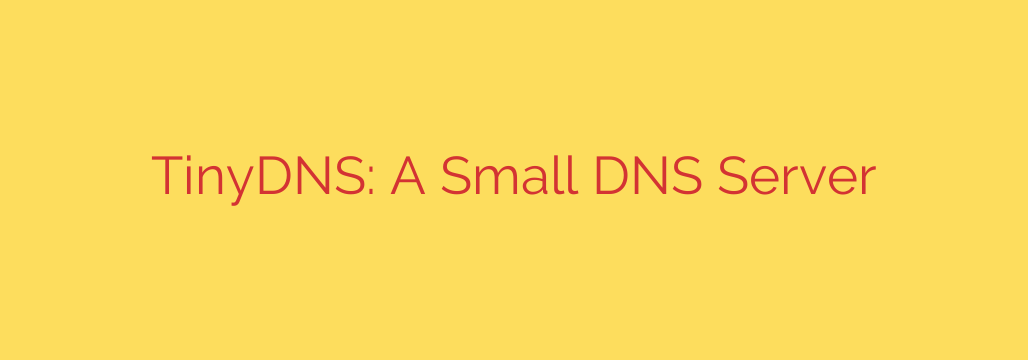
Understanding TinyDNS: A Guide to the Secure and Lightweight DNS Server
In the complex world of internet infrastructure, the Domain Name System (DNS) serves as the indispensable phonebook of the web. It’s a critical component that is often overlooked until it fails. For administrators prioritizing security, performance, and simplicity, one solution has long stood out from the crowd: TinyDNS.
While not as widely known as BIND, TinyDNS offers a powerful, minimalist approach to serving DNS records that remains highly relevant for specific use cases. Let’s explore what makes this small server a giant in terms of security and efficiency.
What is TinyDNS?
TinyDNS is an authoritative-only Domain Name System (DNS) server designed with an intense focus on security and simplicity. It is a key component of the djbdns software suite, a collection of DNS tools created by the renowned security expert Daniel J. Bernstein.
Unlike larger, more complex DNS servers that try to handle every possible function, TinyDNS adheres to the UNIX philosophy of doing one thing and doing it exceptionally well. Its sole purpose is to answer DNS queries for the domains it has been configured to control.
The Core Principles: Security, Speed, and Simplicity
The design of TinyDNS is built on a few uncompromising principles that contribute to its legendary stability and security.
Unmatched Security by Design: Security is not an afterthought in TinyDNS; it is its fundamental design principle. The server has an extremely small and carefully audited codebase, which dramatically reduces its potential attack surface. It runs with minimal privileges and is architecturally separated from other DNS functions, making it highly resistant to common vulnerabilities like cache poisoning.
Simplicity and a Minimalist Footprint: TinyDNS is incredibly lightweight, requiring minimal memory and CPU resources to operate. This makes it an ideal choice for resource-constrained environments like embedded systems, IoT devices, or virtual private servers. Its configuration is managed through a simple, human-readable text file, eliminating the complexity found in other DNS systems.
High Performance and Reliability: By focusing solely on its core task of serving authoritative records, TinyDNS delivers exceptionally fast query responses. It uses a unique, constant database file (
data.cdb) that is both optimized for rapid lookups and immune to runtime modifications. Once the server is running, its data cannot be altered without rebuilding the database file and restarting the service, a feature that enhances both security and stability.
How the TinyDNS Architecture Works
A common point of confusion is understanding that TinyDNS is just one part of the larger djbdns package. The suite deliberately separates DNS roles to enhance security—a practice now considered a modern best practice.
tinydns(The Authoritative Server): This is the core component we are discussing. It reads its configuration from the staticdata.cdbdatabase and answers queries only for the domains listed within it. It will not perform recursive lookups for other domains.dnscache(The Caching/Recursive Server): This is a separate program withindjbdnsthat is designed to handle recursive queries from clients on a network. It queries other DNS servers across the internet and caches the results to speed up future requests.
By separating the authoritative function (tinydns) from the recursive function (dnscache), the system ensures that a potential vulnerability in one cannot be used to compromise the other.
Is TinyDNS Still Relevant Today?
In an era of complex cloud services and feature-rich DNS providers, is there still a place for a minimalist server like TinyDNS? The answer is a resounding yes, particularly in scenarios where security is non-negotiable.
Consider using TinyDNS if you need:
- An internal DNS server for a highly secure network.
- A DNS solution for embedded systems or appliances with limited resources.
- A simple, stable, “set-it-and-forget-it” server for domains with static IP addresses.
- To learn the foundational principles of how DNS works without layers of abstraction.
While it may lack modern features like built-in support for DNSSEC or dynamic updates, its core design remains a benchmark for secure, high-performance software. For complex enterprise environments requiring extensive logging, analytics, and dynamic integrations, modern alternatives like PowerDNS or BIND might be more suitable.
A Key Security Takeaway
The philosophy behind TinyDNS offers a valuable lesson for any system administrator. Regardless of the DNS software you choose, aim to run services with the lowest possible privileges and disable any features you don’t actively need. This principle of minimizing the attack surface is a timeless security practice that dramatically reduces risk.
In conclusion, TinyDNS stands as a testament to the power of secure, minimalist software design. For those who need unparalleled security, high performance, and extreme reliability in an authoritative DNS server, it remains an exceptional choice that has truly stood the test of time.
Source: https://www.linuxlinks.com/tinydns-tiny-dns-server/








